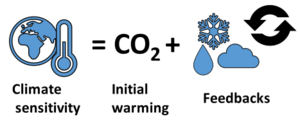Climate sensitivity facts for kids
The Earth is getting warmer because people are putting greenhouse gases into the air. This warming is called the greenhouse effect. The main gas causing this is carbon dioxide (CO2). Burning things like coal puts a lot of CO2 into the air.
Climate sensitivity is about how much the Earth's temperature will go up when a certain amount of CO2 is added to the air. Scientists often talk about what would happen if the amount of CO2 in the air doubled compared to the year 1750. That was before people started burning a lot of coal. Experts believe that if CO2 doubles, the Earth could get about 3 °C warmer.
Contents
How Sensitive is Earth's Climate?
Climate scientists are still working to figure out the exact climate sensitivity. They think it is probably between 1.5 °C and 4.5 °C. This means if CO2 in the air doubled from 1750 levels, the Earth would likely warm up by that amount over a very long time.
How Do Scientists Find This Out?
Scientists use a few ways to understand climate sensitivity:
- They look at temperature records from each year since 1750. They compare these with how much greenhouse gas was in the air at the same time.
- They study the Earth's past. For example, they measure CO2 in tiny air bubbles trapped in ancient polar ice. This shows what the air and temperature were like thousands of years ago.
- They create computer models of the Earth's climate system. These models help them predict how the climate might change.
Why Is Knowing Climate Sensitivity Important?
Knowing the climate sensitivity helps us plan for the future. The Paris Agreement aims to keep global warming below 2°C.
- If the climate is very sensitive, we need to switch to cleaner energy much faster.
- If it's not very sensitive, maybe we don't need to stop using coal power stations as quickly.
So, finding out the exact climate sensitivity is very important for making big decisions.
Why Is It Hard to Figure Out?

It's hard to know the exact climate sensitivity because of something called feedbacks. After greenhouse gases warm the Earth a little, these feedbacks can make the warming faster or slower.
- For example, warmer temperatures cause more water to evaporate from the sea. This water vapor is also a greenhouse gas, which then warms the Earth even more.
Scientists are fairly sure that most feedbacks make the warming faster. But these feedbacks are very complex. Scientists use big computer projects, like the Coupled model intercomparison project (CMIP), to understand them better. One big mystery they are trying to solve is how clouds affect warming, as they can make a huge difference.
Different Ways to Talk About Climate Sensitivity
People talk about climate sensitivity in different ways, depending on if they are looking at the next few decades or thousands of years from now.
When CO2 Stops Increasing Gradually
If CO2 slowly increases each year, the transient climate response (TCR) is the temperature rise when CO2 has doubled. This is likely between 1 °C and 2.5 °C. This idea is useful for thinking about what might happen this century, especially when discussing goals like the Paris Agreement.
When Ocean and Air Temperatures Balance
Most of the extra heat from greenhouse gases warms the oceans. Even after CO2 stops increasing, this heat slowly moves from the oceans and keeps warming the air for thousands of years. The equilibrium climate sensitivity (ECS) is the total temperature the Earth would reach once the air and oceans are balanced, assuming CO2 stays at the doubled level.
Images for kids
-
Frequency distribution of equilibrium climate sensitivity based on simulations of the doubling of CO
2. Each model simulation has different estimates for processes, which scientists do not sufficiently understand. Few of the simulations result in less than 2 °C (3.6 °F) of warming or significantly more than 4 °C (7.2 °F). However, the positive skew, which is also found in other studies, suggests that if carbon dioxide concentrations double, the probability of large or very large increases in temperature is greater than the probability of small increases.
See also
 In Spanish: Sensibilidad climática para niños
In Spanish: Sensibilidad climática para niños


